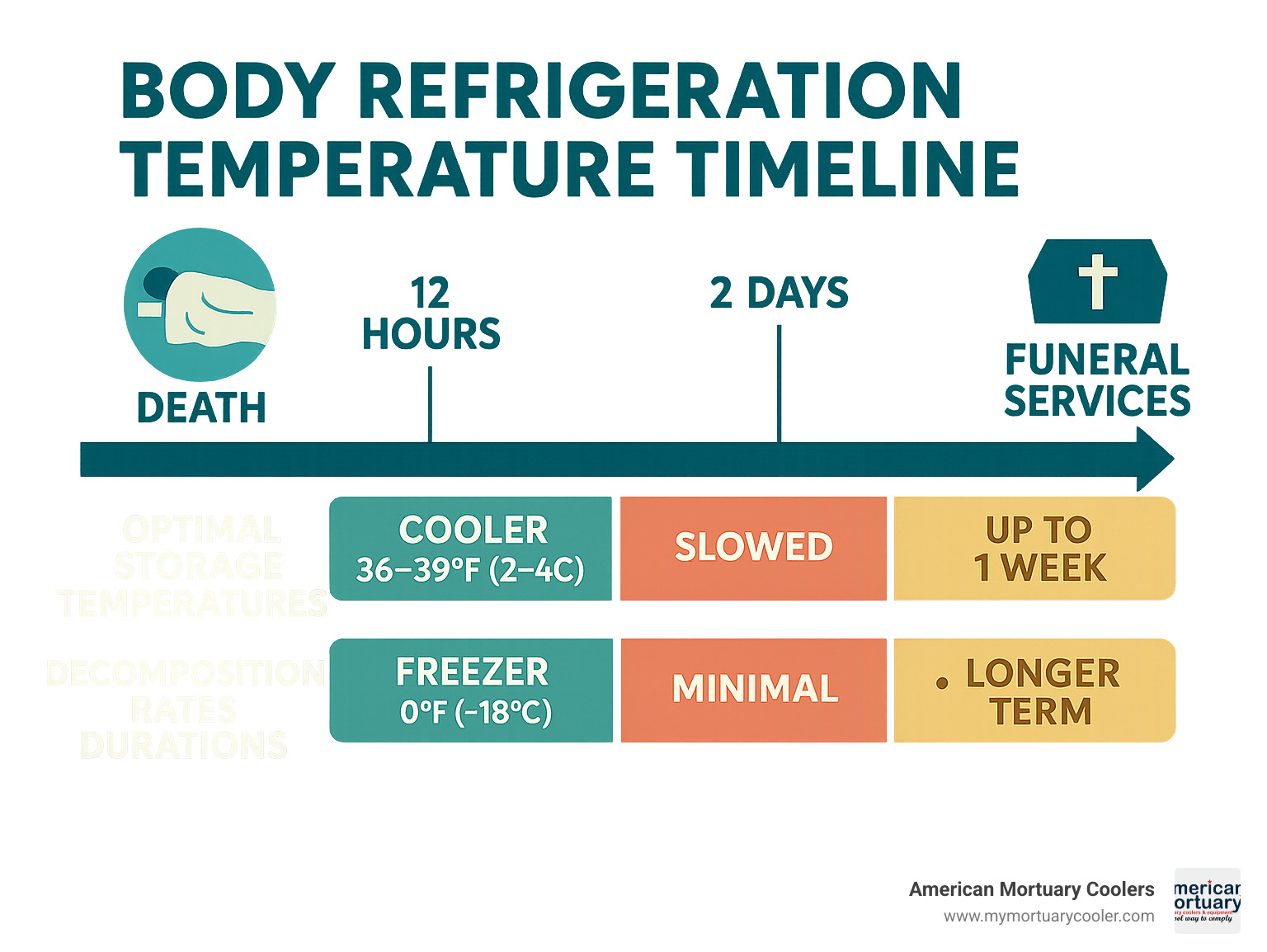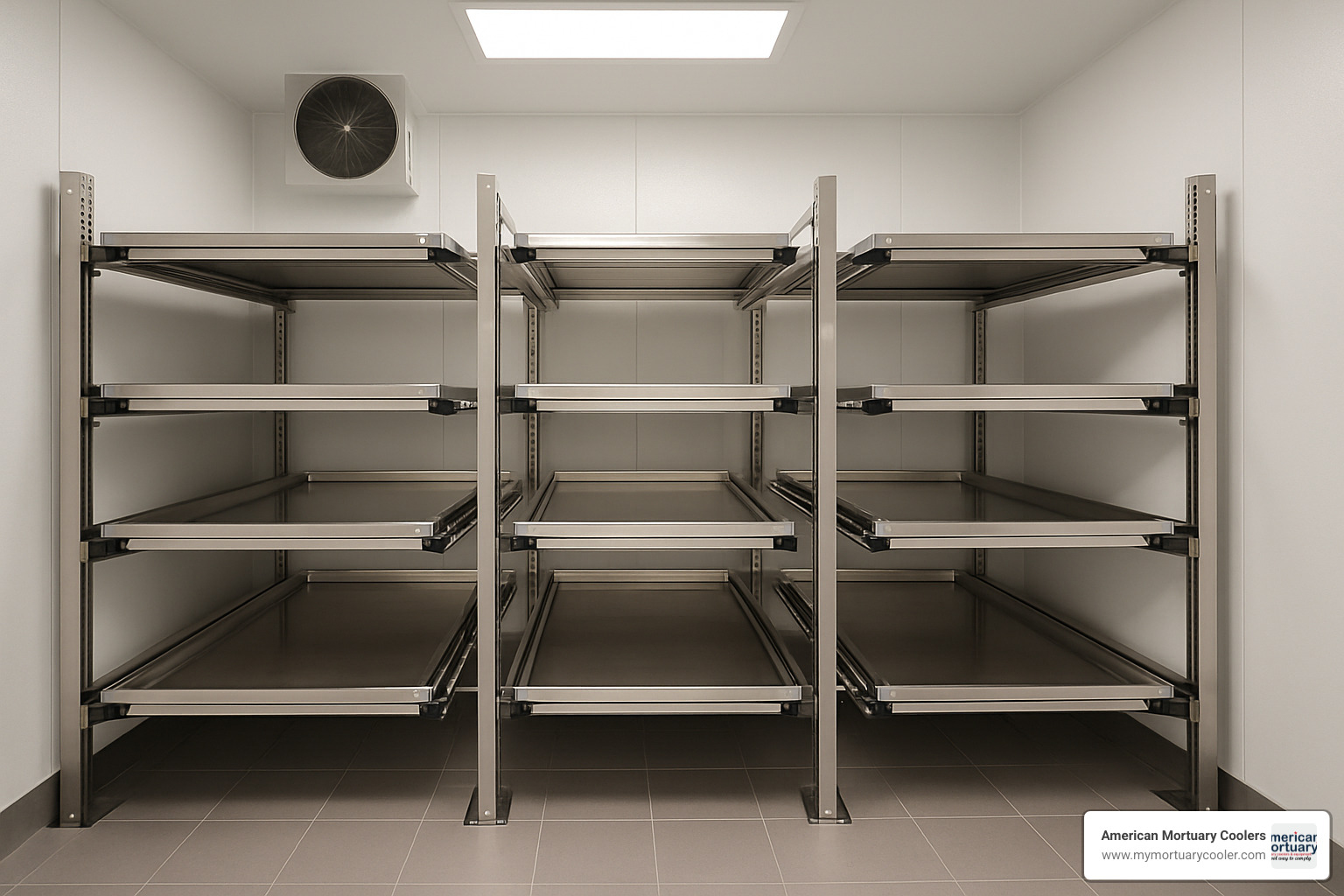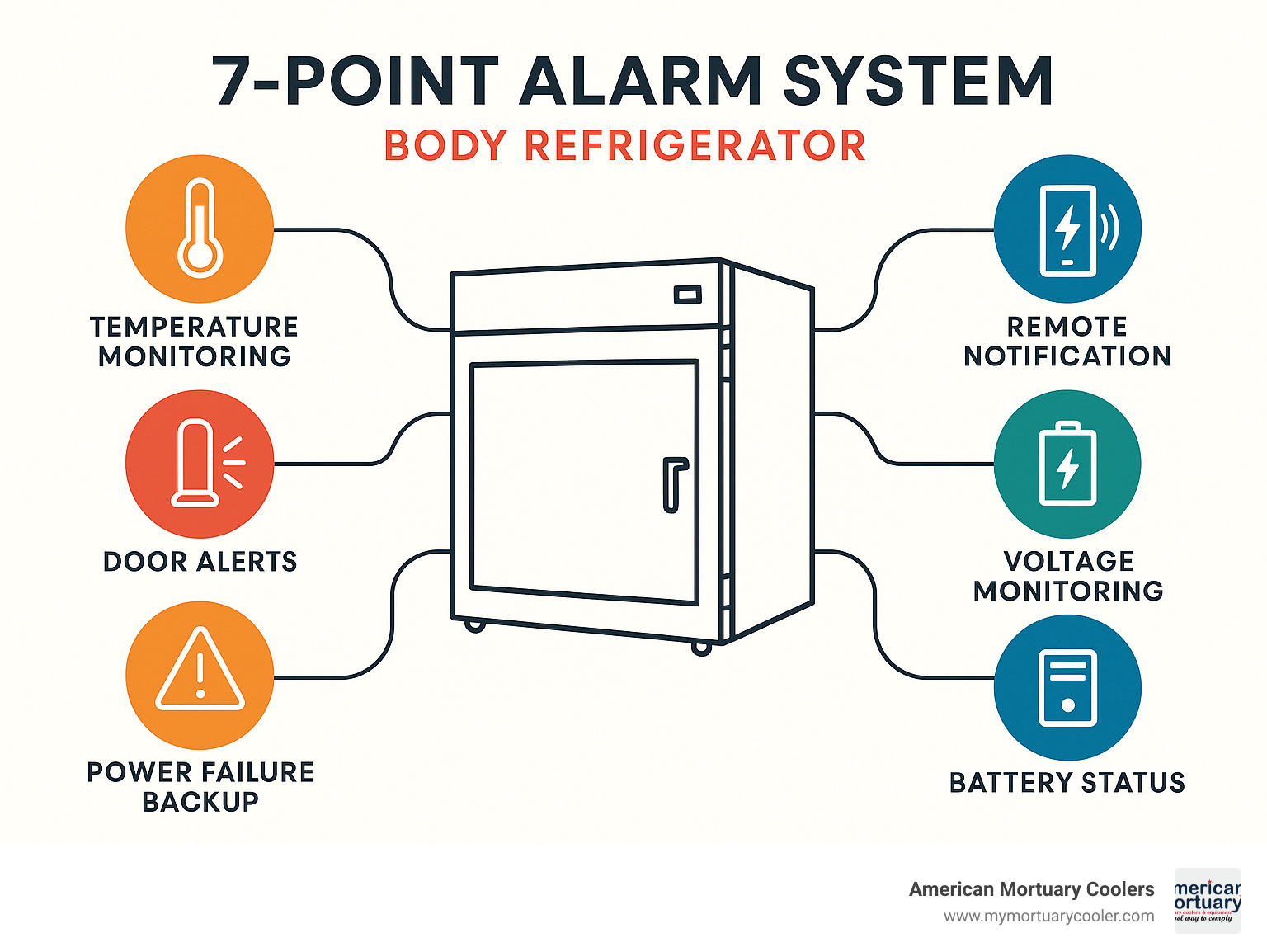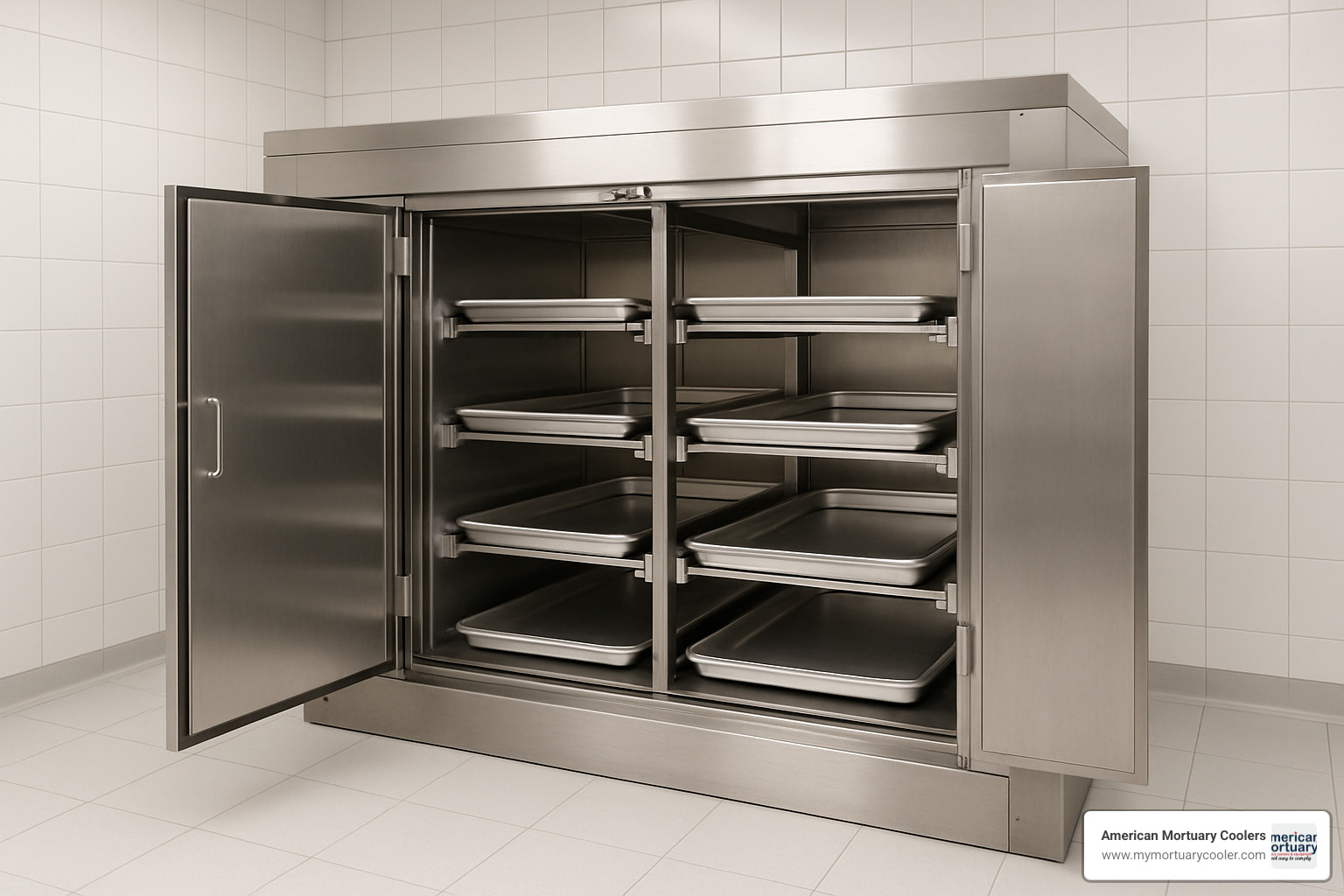Why Body Storage Technology Matters for Modern Funeral Homes
A body-refrigerator- is a specialized cooling system designed to preserve human remains at controlled temperatures, typically 36-39°F for coolers or 0°F for freezers, slowing decomposition and maintaining dignity during funeral preparations.
Quick Body-Refrigerator- Overview:
- Primary Purpose: Preserve deceased at 38°F (3.3°C) standard temperature
- Main Types: Walk-in systems (5-50 bodies), body boxes (2-15 bodies), roll-in units
- Key Features: Stainless steel construction, digital controls, alarm systems
- Capacity Range: Single body units to 50+ body walk-in coolers
- Power Requirements: Standard 110V to 208-230V depending on size
When funeral homes need reliable body preservation, the right refrigeration system becomes critical infrastructure. Modern facilities require equipment that balances space efficiency with dignified storage while meeting strict temperature control standards.
The mortuary refrigeration industry has evolved significantly, with today's units featuring 4-inch polyurethane insulation, OSHA-compliant safety handles, and sophisticated alarm systems that monitor up to seven failure points.
I'm Mortuary Cooler, a national-level mortuary cooler supplier with extensive experience helping funeral homes select the right body-refrigerator- solutions for their specific needs.

Important body-refrigerator- terms:
Why Cold Storage Matters
Proper refrigeration is essential because decomposition begins immediately after death. Without temperature control, bacterial growth accelerates rapidly, making preservation and dignified presentation increasingly difficult. The industry standard of 38°F (3.3°C) effectively slows this natural process, giving families time to grieve and plan services.
Facilities without adequate refrigeration face significant challenges. Bodies stored at room temperature can only be held for a few hours before noticeable changes occur. However, with proper body-refrigerator- systems maintaining 38°F, remains can be preserved for several weeks when necessary, providing the flexibility funeral directors need to serve families with varying timelines.
Understanding Body Refrigerators: Types, Capacities & Configurations
Choosing the right body-refrigerator- requires matching size and features to your actual usage. Walk-in coolers work like giant refrigerated rooms - perfect for busy facilities. Body box units are like oversized refrigerators with multiple compartments, ideal for smaller operations. Roll-in systems work with gurneys, while upright models function like morgue drawers.
Capacity varies dramatically. Single-body units start around $5,799 for backup storage. Mid-range body box systems handle 2-15 bodies, while large walk-in coolers store 5-50 bodies depending on interior rack configuration.
Modern units use modular panel construction with 4-inch thick insulation for excellent energy efficiency. These panels snap together with cam-locks, making installation straightforward and allowing expansion or relocation.
Key differences between coolers and freezers:
| Feature | Cooler | Freezer |
|---|---|---|
| Temperature | 36-39°F (2-4°C) | 0°F (-18°C) |
| Purpose | Short-term preservation | Long-term storage |
| Energy Use | Lower | Higher |
| Typical Use | Funeral homes | Forensic labs |
| Storage Duration | Days to weeks | Weeks to months |
Most funeral homes need coolers, not freezers. The 36-39°F range provides excellent preservation for typical timeframes while using significantly less energy.
Core Body-Refrigerator- Types & When to Use Them
Walk-in systems are the workhorse option for high-volume facilities. These prefabricated units use precision-formed metal-clad insulated panels. We recommend walk-in coolers for facilities regularly handling more than 8-10 bodies, since they maximize storage density while providing excellent accessibility.
Walk-in systems offer incredible flexibility. Need more space? Add another panel section. Moving locations? The modular design allows complete disassembly and relocation.
Mobile units serve specialized needs, particularly for disaster response and temporary storage. These wheeled systems plug into standard 110V outlets and can be relocated as needed.
For detailed information about different body-refrigerator- types: Cold Comfort: Understanding the Body Refrigerator.
Body box refrigerators work well for smaller facilities or supplemental storage. These compact units handle 2-15 bodies in various loading styles. Roll-in configurations work with gurneys and cadaver lifts. Upright models function like traditional morgue drawers. Side-loading units open from the side, perfect for tight prep room layouts.
Standard Capacities & Rack Layouts
Body box systems typically offer 2-15 body capacity with tiered shelving options. Many feature heated door frames to prevent frost buildup and digital thermometer readouts for easy temperature monitoring.
Walk-in systems offer higher capacity with standard configurations storing 4-5, 8-10, 16-20, or 24-30 bodies. Large installations can accommodate up to 50 bodies using specialized rack systems.
Cantilever racks maximize floor space by extending from wall mounts without floor support posts. Telescoping rails support storage trays that extend up to three-quarters of their length, making transfers with cadaver lifts safer and easier.

Bariatric bays require special consideration with extra-wide door openings (typically 36 inches) and reinforced trays to accommodate oversized cases. The telescopic rack mechanism uses extruded aluminum with nylon rollers, providing smooth operation while supporting substantial weight and improving worker safety.
Key Features & Technology That Keep Corpses Cold
Modern body-refrigerator- systems aren't just big refrigerators—they're sophisticated systems designed specifically for body storage challenges.
Forced cold-air circulation ensures every corner maintains the same temperature, eliminating dangerous hot spots. Intelligence-controlled fans automatically adjust based on storage load, working harder when fully loaded and conserving energy during lighter periods.
Digital controllers maintain precision within tight ranges, typically adjustable from -16°C to 6°C. These computer-controlled systems keep your body-refrigerator- exactly where you set it, unlike mechanical thermostats that drift over time.
Comprehensive alarm systems monitor up to seven critical failure points: high and low temperature alerts, sensor malfunctions, door-open warnings, power failures, low battery conditions, and voltage irregularities. Remote monitoring capability means you receive alerts at home or on your phone, with built-in lithium batteries supporting alarm operation for up to 72 hours after power outages.
Construction quality uses Stainless steel Type 304 for durability and hygiene, while 4-inch thick polyurethane foam insulation delivers exceptional energy efficiency. Every unit includes OSHA-compliant safety release handles—critical for personnel safety.
For technical specifications: Scientific research on refrigeration panels.
Redundancy features include optional backup cooling systems and dual compressor configurations ensuring your body-refrigerator- keeps running even if one component fails.
Temperature Ranges & Uniform Cooling
Cooler models operate at 36-39°F, effectively slowing decomposition without freezing tissue. This preserves appearance and allows normal preparation procedures.
Freezer models reach 0°F for long-term storage needs. Forensic applications, extended legal holds, or cases requiring extended time often benefit from freezer temperatures.
Independent chamber control provides incredible flexibility. Different areas can maintain different temperatures, accommodating varying preservation needs.
Uniform cooling uses low-speed, double-flow evaporators preventing cold drafts while ensuring consistent temperatures. Multiple temperature sensors provide continuous monitoring with 24-hour data logging and power-off memory protection.
Safety & Monitoring Systems
Modern body-refrigerator- systems include sophisticated safety features protecting both facilities and staff. High and low temperature alarms immediately alert you to unacceptable conditions, while door-open alerts prevent energy loss and temperature fluctuations.
Power failure alarms with battery backup ensure continuous monitoring during electrical outages, protecting your investment regardless of external circumstances.

Self-checking functions continuously verify sensor and system operation. Password protection and keyboard locks prevent unauthorized changes to critical settings.
Advanced monitoring includes sensor failure detection, low battery warnings, and low voltage alerts. RS-232 PC communication enables facility management system integration, while 24-hour recording provides documentation for regulatory compliance.
Remote signal alarm capability allows integration with facility-wide monitoring systems, changing your body-refrigerator- into part of your comprehensive safety network.
How to Choose the Right Body-Refrigerator- for Your Facility
Choosing the perfect body-refrigerator- starts with four key questions: How much space do you have? How many bodies do you typically handle? How does your staff work best? And what can you realistically afford?
Most facilities underestimate future needs. That small funeral home handling 2-3 bodies monthly might seem fine with a compact 2-body unit today, but when business grows, you'll wish you'd invested in that 4-6 body system instead.
Modern body-refrigerator- systems offer incredible flexibility through customization and financing options. Whether you need a basic roll-in cooler or sophisticated walk-in system with telescoping racks, there's likely a solution fitting both needs and budget.
For comprehensive selection guidance: The Complete Guide to Choosing a Body Storage Refrigerator.
Don't forget long-term costs. Well-insulated units cost more upfront but save hundreds annually in energy costs. Over 10 years, that "expensive" efficient model often becomes the bargain choice.
Assessing Space, Capacity & Workflow
Before selecting any body-refrigerator-, measure your space realistically. Start with floor plan measurements, including ceiling height and doorway dimensions. That beautiful 2-body refrigerator measuring 38" wide × 97" deep × 79" high needs to actually fit through your doors with adequate operational clearance.
Loading style significantly impacts daily operations. Roll-in units work beautifully when bodies arrive on gurneys. Upright loading suits facilities with hydraulic lifts. Side-loading configurations are lifesavers in narrow prep rooms where front access feels cramped.
If considering telescoping slide rails, they cost more initially but make body handling much easier. Those nylon rollers and smooth aluminum tracks turn physically demanding tasks into something more manageable.
Capacity planning requires thinking about worst days, not average ones. Holiday weekends, flu seasons, and unexpected events can suddenly fill storage beyond normal levels. We recommend sizing systems for 150-200% of typical capacity.
Budget, ROI & Financing Options
Entry-level single-body roll-in coolers start around $5,799, working well for smaller operations. Premium 8-body units with telescoping slide-rail systems can exceed $33,000, but provide excellent value for high-volume facilities.
Walk-in systems cost more upfront but often provide the best per-body storage value. Think of it like buying in bulk—per-body storage costs drop significantly as capacity increases.
Energy costs deserve serious consideration because they never stop. Modern units with superior insulation typically use 20-30% less energy than older designs. In busy facilities, these savings can offset higher initial costs within 3-5 years.
Many suppliers now offer 0% down financing with no payments for 90 days, subject to credit approval. When calculating ROI, don't forget indirect benefits like fewer emergency service calls, happier staff, and improved family service.
Customization Checklist for a Body-Refrigerator-
Door types significantly impact workflow and costs. Standard overlap doors with magnetic gaskets provide reliable sealing at reasonable prices. Sliding doors work great in tight spaces, while specialized configurations handle unique situations.

Rack style selection affects storage capacity and staff comfort. Standard fixed racks provide basic functionality at lower cost. Cantilever systems maximize storage density. Roller racks with telescoping mechanisms cost more but make body handling much easier.
Bariatric width requirements depend on service area demographics. Standard 27-inch body trays accommodate most cases, but facilities in areas with higher obesity rates benefit from extra-wide configurations with 36-inch door openings.
Alarm system upgrades provide invaluable peace of mind. Basic systems include high/low temperature alerts, while premium packages add door monitoring, power failure backup, remote notifications, and data logging.
Installation, Maintenance & Compliance Essentials
Getting your new body-refrigerator- properly installed sets the foundation for reliable service. Most modern units feature installation simplicity, though important details matter.
Site preparation starts with adequate electrical service. Smaller units typically run on 110V power, while larger systems need 208-230V service. Many units feature plug-and-play designs, though remote condenser systems require professional refrigeration service.
Cleaning protocols are essential for maintaining hygienic conditions and equipment longevity. Stainless steel surfaces need specific cleaning agents to prevent corrosion. Preventive maintenance schedules typically include quarterly inspections, annual refrigeration system service, and periodic temperature control calibration.
For detailed maintenance guidance: More info about maintenance best practices.
Step-by-Step Install Guide
Delivery coordination is crucial, especially for larger units. Assembled units may need forklift equipment, while knocked-down shipments cost less but require on-site assembly. Lift-gate service adds about $75 but eliminates special unloading equipment needs.
Assembly procedures for modular units are straightforward. Most use cam-lock connections completable with basic tools: cam-lock wrench, power drill, drill bits, socket wrench, level, rubber mallet, and tape measure. Single-technician installations typically take about an hour.
Panel installation follows specific sequences ensuring proper sealing and structural integrity. Commissioning involves verifying all systems work properly—refrigeration, controls, alarms, and safety features.
Regulatory & Certification Snapshot
NSF certification ensures food-safe panel components meet hygiene standards. While not specifically required for mortuary use, NSF-certified components demonstrate commitment to cleanliness and quality construction.
OSHA compliance focuses on safety release handles allowing personnel to exit refrigerated spaces in emergencies. UL electrical certification verifies safe electrical design, particularly important for complex control systems.
Local code compliance varies by jurisdiction but often includes building permits, electrical permits, and health department approvals.
Service & Troubleshooting Tips
Coil cleaning represents the most critical routine maintenance task. Dirty condenser coils reduce efficiency, increase energy consumption, and can cause premature compressor failure. Cleaning frequency typically ranges from monthly to quarterly depending on environmental conditions.
Gasket inspection prevents air leaks compromising temperature control. Look for cracks, tears, or hardening indicating replacement time. Temperature calibration should be verified annually using certified reference thermometers, ensuring compliance with preservation standards.
Frequently Asked Questions about Body Refrigerators
What temperature should my body refrigerator run at?
Your body-refrigerator- should maintain a steady 38°F (3.3°C) for standard preservation needs. This temperature slows decomposition significantly without freezing tissue and damaging appearance for viewing.
Modern digital controllers maintain accuracy within 0.1°C, not the wild swings from older mechanical systems. If you need long-term storage, freezer models running at 0°F (-17.8°C) work well for forensic cases or situations requiring weeks or months of storage.
Some facilities benefit from independent chamber control, where different sections run at different temperatures for varying timeline needs.
What's the difference between a cooler and a freezer model?
Coolers operating at 36-39°F handle typical funeral home workflow perfectly—preserving remains for days to weeks while families plan services. Freezers at 0°F are built for long-term preservation, talking weeks to months instead of days to weeks.
Your wallet will notice the difference. Freezers typically cost 40-60% more to operate than coolers because maintaining sub-zero temperatures requires significantly more energy. Unless you specifically need extended preservation capability, coolers usually make more financial sense for funeral operations.
How often should I service the refrigeration system?
Professional service once a year keeps most systems running smoothly, but high-volume facilities should consider quarterly check-ups. Service should verify refrigerant levels, test compressor performance, inspect electrical connections, and calibrate temperature controls.
Don't wait for problems to develop. Your daily routine should include checking temperatures and testing alarms—takes less than two minutes but can save major headaches. Monthly coil cleaning and gasket inspection prevent most common problems.
Your body-refrigerator- is critical infrastructure. The families you serve depend on reliable preservation, and proper maintenance ensures you can deliver that reliability consistently.
Conclusion & Next Steps
Selecting the perfect body-refrigerator- for your facility comes down to understanding your unique needs. Every funeral home operates differently, and what works brilliantly for a high-volume urban facility might be completely wrong for a small-town operation. The key is finding that sweet spot between current capacity requirements, available space, daily workflow patterns, and realistic budget considerations.
We've walked through the essential factors together—from understanding the difference between cooler and freezer models to evaluating sophisticated alarm systems and customization options. Modern body-refrigerator- systems offer remarkable capabilities that would have seemed impossible just a decade ago. Precise digital temperature control, comprehensive monitoring, and energy-efficient operation mean today's units can serve your facility reliably for twenty years or more.
At American Mortuary Coolers, we've built our reputation on understanding that no two facilities are exactly alike. From our Tennessee headquarters, we design and deliver custom mortuary cooling solutions across all 48 contiguous states. Our team has worked with everything from small rural funeral homes needing their first 2-body unit to major metropolitan facilities requiring complex walk-in systems with specialized bariatric configurations.
What sets us apart is our commitment to future-proofing your investment. The modular panel construction we use in our walk-in systems means you're not locked into today's configuration forever. As your business grows or your space changes, these systems can be disassembled, relocated, and even expanded. It's like buying equipment that grows with you rather than becoming obsolete.
Here's what successful facilities focus on when making their final decision: assessing both current and projected capacity needs honestly, measuring available space carefully including those tricky doorway dimensions, evaluating workflow preferences between roll-in, upright, and side-loading options, determining realistic budgets including our 0% down financing options, considering necessary customizations like bariatric capabilities or specialized alarm systems, planning for professional installation and ongoing maintenance requirements, and verifying all regulatory compliance needs for your jurisdiction.
The smartest funeral directors we work with think beyond just solving today's problem. They choose systems with room to grow, standardized components for long-term service availability, and manufacturers who'll still be around in fifteen years when they need parts or upgrades.
Ready to explore your options? Visit our complete line of mortuary refrigeration solutions at mymortuarycooler.com. Our specialists understand the funeral industry inside and out, and we're here to help you design the perfect body-refrigerator- system that'll serve your families with dignity for decades to come.
















